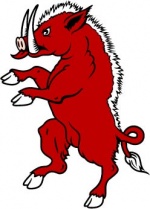Boar: Difference between revisions
(categorising) |
(added historical note; hunting and Richard the Third) |
||
| Line 11: | Line 11: | ||
Despite what the animal rights extremists believed about their possible poor treatment as least one little piggy went all the way home and let himself back into the original property. |
Despite what the animal rights extremists believed about their possible poor treatment as least one little piggy went all the way home and let himself back into the original property. |
||
== Boar Hunting == |
|||
The wild boar was considered the premiere animal for medieval hunter to prove his prowess. |
|||
==== Note -- boar spears ==== |
==== Note -- boar spears ==== |
||
The '''boar''' tends to attack by charging and goring with its teeth and tusks. The boar [[spear]] is intended to counter this, by being thrust into the boar as it charges. The large cross piece just below the blade of the head is there to hold the animal at bay so that it will not gore you. |
The '''boar''' tends to attack by charging and goring with its teeth and tusks. The boar [[spear]] is intended to counter this, by being thrust into the boar as it charges. The large cross piece just below the blade of the head is there to hold the animal at bay so that it will not gore you. |
||
== Heraldic Boar == |
|||
Like many other common medieval European animals, the boar was used in [[heraldry]] most memorably perhaps by King Richard the Third. |
|||
From |
From |
||
Revision as of 07:20, 21 July 2006
Male pig
See also (in some cases) stickjock
Wild Boar
Sus scrofa scrofa is the scientific name for the wild boar. Once common in Europe they have more recently been reintroduced into some European countries. Adult wild boar grow to around 200 kg for males and around 130kg for the females and have short bristly hair. Males develop tusks after around two years of age.
Wild boars are currently bred for their meat in Britain and recently animal right extremists released 60 in late December 2006 into the wild where another 500 are thought to exist. This caused panic and fear amongst the locals as the animals ran through local villages.
Despite what the animal rights extremists believed about their possible poor treatment as least one little piggy went all the way home and let himself back into the original property.
Boar Hunting
The wild boar was considered the premiere animal for medieval hunter to prove his prowess.
Note -- boar spears
The boar tends to attack by charging and goring with its teeth and tusks. The boar spear is intended to counter this, by being thrust into the boar as it charges. The large cross piece just below the blade of the head is there to hold the animal at bay so that it will not gore you.
Heraldic Boar
Like many other common medieval European animals, the boar was used in heraldry most memorably perhaps by King Richard the Third.
From
This article is a stub. You can help Cunnan by expanding it.
